Duolever: Financial Analysis of Plastic Packaging Recycling Options
VerifiedAdded on 2023/01/18
|6
|1516
|33
Report
AI Summary
This memo presents a financial analysis of Duolever's plastic sachet waste recycling options. The company faces a decision between investing in a new recycling plant or licensing its patented method to Clean World Ltd. The analysis employs Net Present Value (NPV) and Internal Rate of Return (IRR) to evaluate the profitability of each option. The report details the assumptions, including revenue growth, variable costs, and tax rates, for both scenarios. The investment option involves increased revenues and cost savings due to recycling, while the licensing option offers revenue from the patented method with no initial investment. The NPV calculations indicate that the licensing option is more profitable, leading to the recommendation that Duolever should license its method. The memo also highlights the importance of understanding forecasting risks and the impact of key assumptions on the financial outcomes. The appendix provides detailed cash flow analyses for both options.
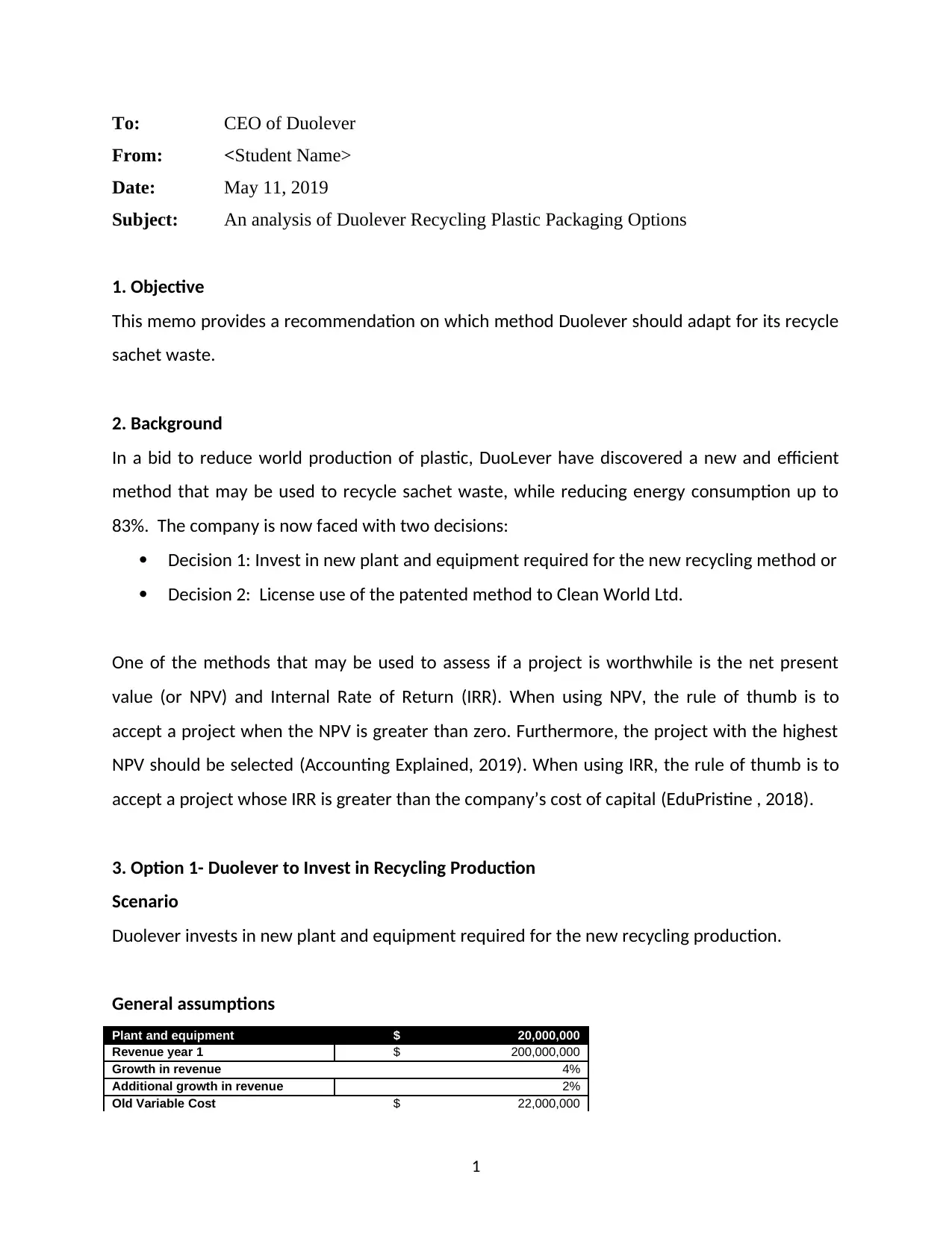
To: CEO of Duolever
From: <Student Name>
Date: May 11, 2019
Subject: An analysis of Duolever Recycling Plastic Packaging Options
1. Objective
This memo provides a recommendation on which method Duolever should adapt for its recycle
sachet waste.
2. Background
In a bid to reduce world production of plastic, DuoLever have discovered a new and efficient
method that may be used to recycle sachet waste, while reducing energy consumption up to
83%. The company is now faced with two decisions:
Decision 1: Invest in new plant and equipment required for the new recycling method or
Decision 2: License use of the patented method to Clean World Ltd.
One of the methods that may be used to assess if a project is worthwhile is the net present
value (or NPV) and Internal Rate of Return (IRR). When using NPV, the rule of thumb is to
accept a project when the NPV is greater than zero. Furthermore, the project with the highest
NPV should be selected (Accounting Explained, 2019). When using IRR, the rule of thumb is to
accept a project whose IRR is greater than the company’s cost of capital (EduPristine , 2018).
3. Option 1- Duolever to Invest in Recycling Production
Scenario
Duolever invests in new plant and equipment required for the new recycling production.
General assumptions
Plant and equipment $ 20,000,000
Revenue year 1 $ 200,000,000
Growth in revenue 4%
Additional growth in revenue 2%
Old Variable Cost $ 22,000,000
1
From: <Student Name>
Date: May 11, 2019
Subject: An analysis of Duolever Recycling Plastic Packaging Options
1. Objective
This memo provides a recommendation on which method Duolever should adapt for its recycle
sachet waste.
2. Background
In a bid to reduce world production of plastic, DuoLever have discovered a new and efficient
method that may be used to recycle sachet waste, while reducing energy consumption up to
83%. The company is now faced with two decisions:
Decision 1: Invest in new plant and equipment required for the new recycling method or
Decision 2: License use of the patented method to Clean World Ltd.
One of the methods that may be used to assess if a project is worthwhile is the net present
value (or NPV) and Internal Rate of Return (IRR). When using NPV, the rule of thumb is to
accept a project when the NPV is greater than zero. Furthermore, the project with the highest
NPV should be selected (Accounting Explained, 2019). When using IRR, the rule of thumb is to
accept a project whose IRR is greater than the company’s cost of capital (EduPristine , 2018).
3. Option 1- Duolever to Invest in Recycling Production
Scenario
Duolever invests in new plant and equipment required for the new recycling production.
General assumptions
Plant and equipment $ 20,000,000
Revenue year 1 $ 200,000,000
Growth in revenue 4%
Additional growth in revenue 2%
Old Variable Cost $ 22,000,000
1
Paraphrase This Document
Need a fresh take? Get an instant paraphrase of this document with our AI Paraphraser
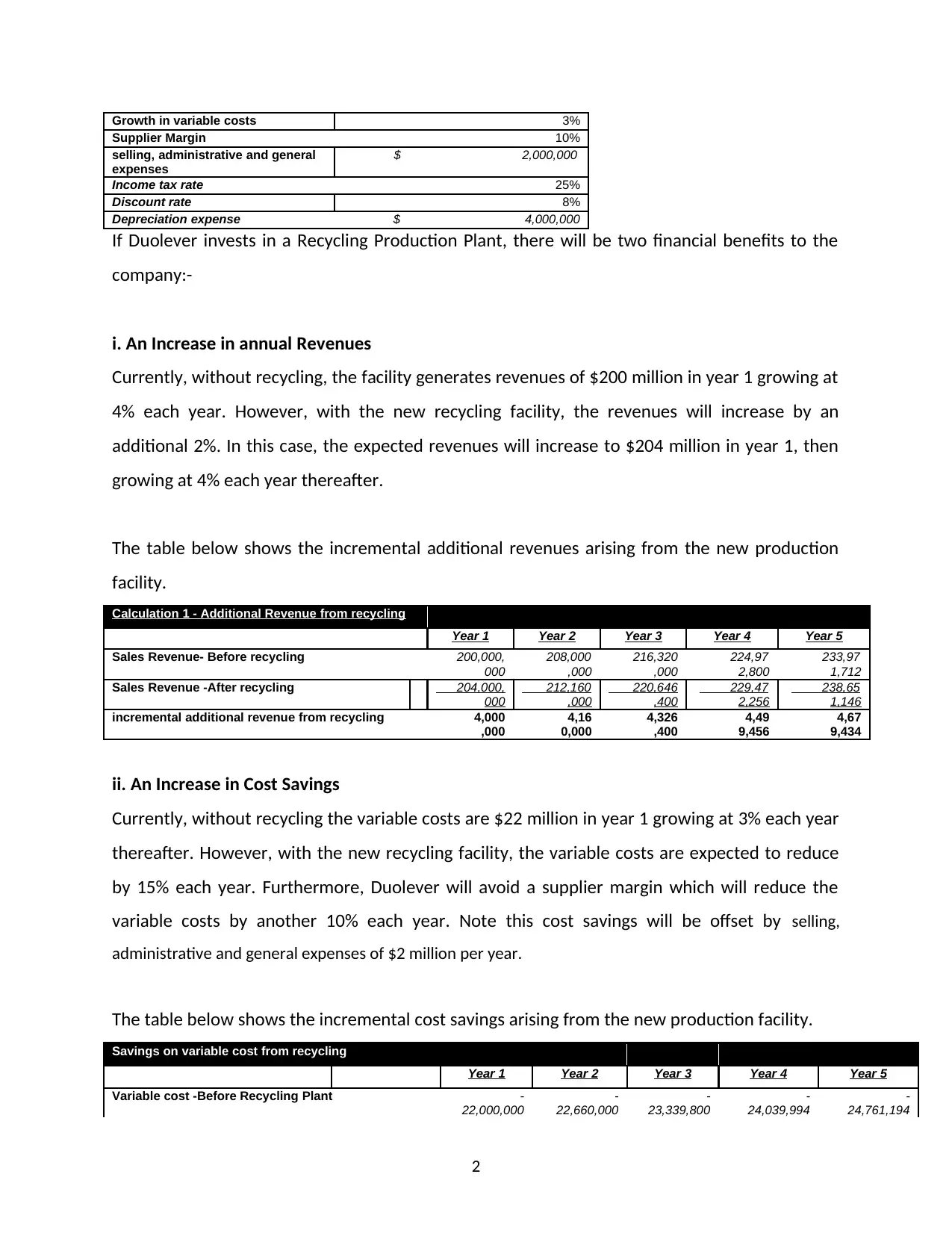
Growth in variable costs 3%
Supplier Margin 10%
selling, administrative and general
expenses
$ 2,000,000
Income tax rate 25%
Discount rate 8%
Depreciation expense $ 4,000,000
If Duolever invests in a Recycling Production Plant, there will be two financial benefits to the
company:-
i. An Increase in annual Revenues
Currently, without recycling, the facility generates revenues of $200 million in year 1 growing at
4% each year. However, with the new recycling facility, the revenues will increase by an
additional 2%. In this case, the expected revenues will increase to $204 million in year 1, then
growing at 4% each year thereafter.
The table below shows the incremental additional revenues arising from the new production
facility.
Calculation 1 - Additional Revenue from recycling
Year 1 Year 2 Year 3 Year 4 Year 5
Sales Revenue- Before recycling 200,000,
000
208,000
,000
216,320
,000
224,97
2,800
233,97
1,712
Sales Revenue -After recycling 204,000,
000
212,160
,000
220,646
,400
229,47
2,256
238,65
1,146
incremental additional revenue from recycling 4,000
,000
4,16
0,000
4,326
,400
4,49
9,456
4,67
9,434
ii. An Increase in Cost Savings
Currently, without recycling the variable costs are $22 million in year 1 growing at 3% each year
thereafter. However, with the new recycling facility, the variable costs are expected to reduce
by 15% each year. Furthermore, Duolever will avoid a supplier margin which will reduce the
variable costs by another 10% each year. Note this cost savings will be offset by selling,
administrative and general expenses of $2 million per year.
The table below shows the incremental cost savings arising from the new production facility.
Savings on variable cost from recycling
Year 1 Year 2 Year 3 Year 4 Year 5
Variable cost -Before Recycling Plant -
22,000,000
-
22,660,000
-
23,339,800
-
24,039,994
-
24,761,194
2
Supplier Margin 10%
selling, administrative and general
expenses
$ 2,000,000
Income tax rate 25%
Discount rate 8%
Depreciation expense $ 4,000,000
If Duolever invests in a Recycling Production Plant, there will be two financial benefits to the
company:-
i. An Increase in annual Revenues
Currently, without recycling, the facility generates revenues of $200 million in year 1 growing at
4% each year. However, with the new recycling facility, the revenues will increase by an
additional 2%. In this case, the expected revenues will increase to $204 million in year 1, then
growing at 4% each year thereafter.
The table below shows the incremental additional revenues arising from the new production
facility.
Calculation 1 - Additional Revenue from recycling
Year 1 Year 2 Year 3 Year 4 Year 5
Sales Revenue- Before recycling 200,000,
000
208,000
,000
216,320
,000
224,97
2,800
233,97
1,712
Sales Revenue -After recycling 204,000,
000
212,160
,000
220,646
,400
229,47
2,256
238,65
1,146
incremental additional revenue from recycling 4,000
,000
4,16
0,000
4,326
,400
4,49
9,456
4,67
9,434
ii. An Increase in Cost Savings
Currently, without recycling the variable costs are $22 million in year 1 growing at 3% each year
thereafter. However, with the new recycling facility, the variable costs are expected to reduce
by 15% each year. Furthermore, Duolever will avoid a supplier margin which will reduce the
variable costs by another 10% each year. Note this cost savings will be offset by selling,
administrative and general expenses of $2 million per year.
The table below shows the incremental cost savings arising from the new production facility.
Savings on variable cost from recycling
Year 1 Year 2 Year 3 Year 4 Year 5
Variable cost -Before Recycling Plant -
22,000,000
-
22,660,000
-
23,339,800
-
24,039,994
-
24,761,194
2
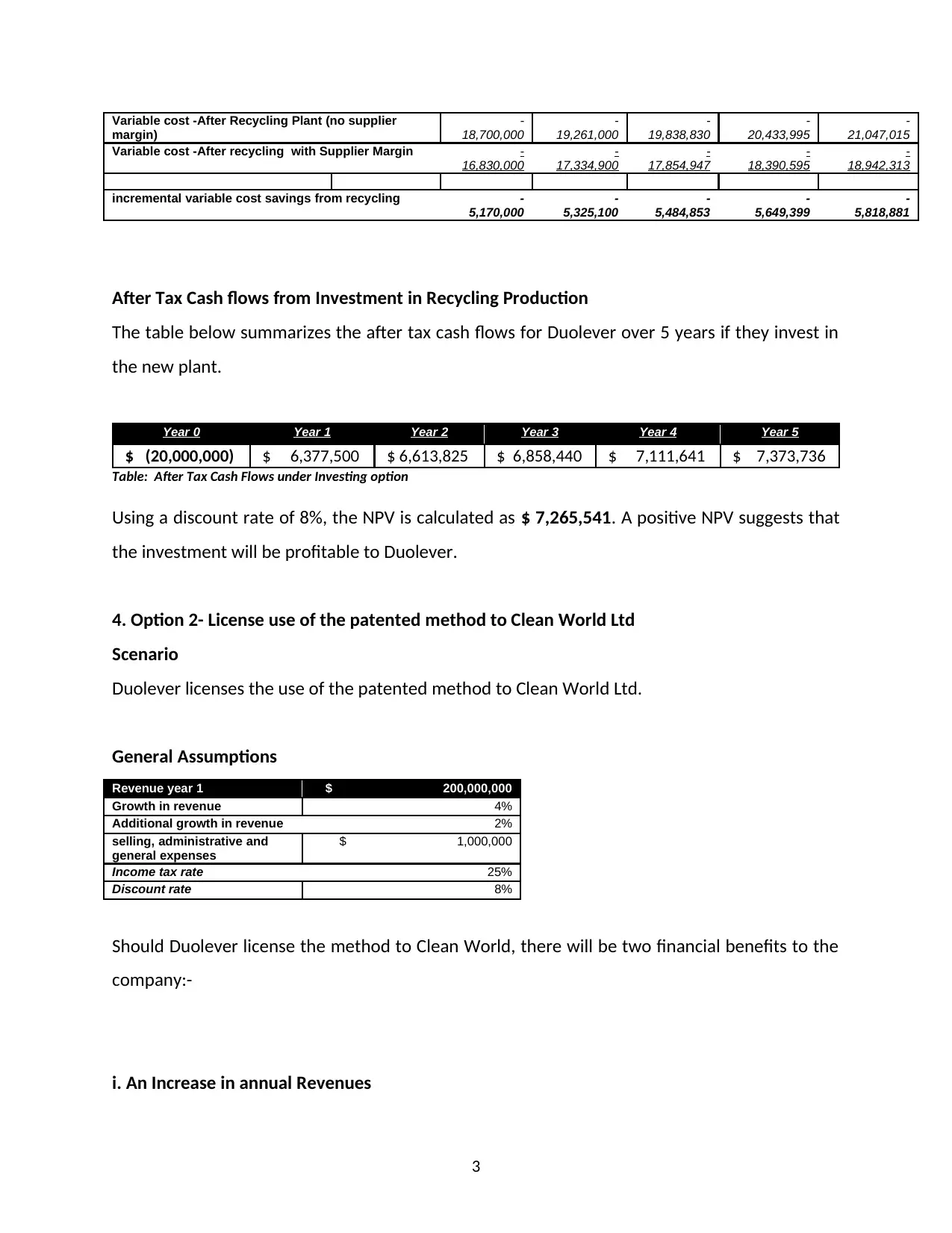
Variable cost -After Recycling Plant (no supplier
margin)
-
18,700,000
-
19,261,000
-
19,838,830
-
20,433,995
-
21,047,015
Variable cost -After recycling with Supplier Margin -
16,830,000
-
17,334,900
-
17,854,947
-
18,390,595
-
18,942,313
incremental variable cost savings from recycling -
5,170,000
-
5,325,100
-
5,484,853
-
5,649,399
-
5,818,881
After Tax Cash flows from Investment in Recycling Production
The table below summarizes the after tax cash flows for Duolever over 5 years if they invest in
the new plant.
Year 0 Year 1 Year 2 Year 3 Year 4 Year 5
$ (20,000,000) $ 6,377,500 $ 6,613,825 $ 6,858,440 $ 7,111,641 $ 7,373,736
Table: After Tax Cash Flows under Investing option
Using a discount rate of 8%, the NPV is calculated as $ 7,265,541. A positive NPV suggests that
the investment will be profitable to Duolever.
4. Option 2- License use of the patented method to Clean World Ltd
Scenario
Duolever licenses the use of the patented method to Clean World Ltd.
General Assumptions
Revenue year 1 $ 200,000,000
Growth in revenue 4%
Additional growth in revenue 2%
selling, administrative and
general expenses
$ 1,000,000
Income tax rate 25%
Discount rate 8%
Should Duolever license the method to Clean World, there will be two financial benefits to the
company:-
i. An Increase in annual Revenues
3
margin)
-
18,700,000
-
19,261,000
-
19,838,830
-
20,433,995
-
21,047,015
Variable cost -After recycling with Supplier Margin -
16,830,000
-
17,334,900
-
17,854,947
-
18,390,595
-
18,942,313
incremental variable cost savings from recycling -
5,170,000
-
5,325,100
-
5,484,853
-
5,649,399
-
5,818,881
After Tax Cash flows from Investment in Recycling Production
The table below summarizes the after tax cash flows for Duolever over 5 years if they invest in
the new plant.
Year 0 Year 1 Year 2 Year 3 Year 4 Year 5
$ (20,000,000) $ 6,377,500 $ 6,613,825 $ 6,858,440 $ 7,111,641 $ 7,373,736
Table: After Tax Cash Flows under Investing option
Using a discount rate of 8%, the NPV is calculated as $ 7,265,541. A positive NPV suggests that
the investment will be profitable to Duolever.
4. Option 2- License use of the patented method to Clean World Ltd
Scenario
Duolever licenses the use of the patented method to Clean World Ltd.
General Assumptions
Revenue year 1 $ 200,000,000
Growth in revenue 4%
Additional growth in revenue 2%
selling, administrative and
general expenses
$ 1,000,000
Income tax rate 25%
Discount rate 8%
Should Duolever license the method to Clean World, there will be two financial benefits to the
company:-
i. An Increase in annual Revenues
3
⊘ This is a preview!⊘
Do you want full access?
Subscribe today to unlock all pages.

Trusted by 1+ million students worldwide
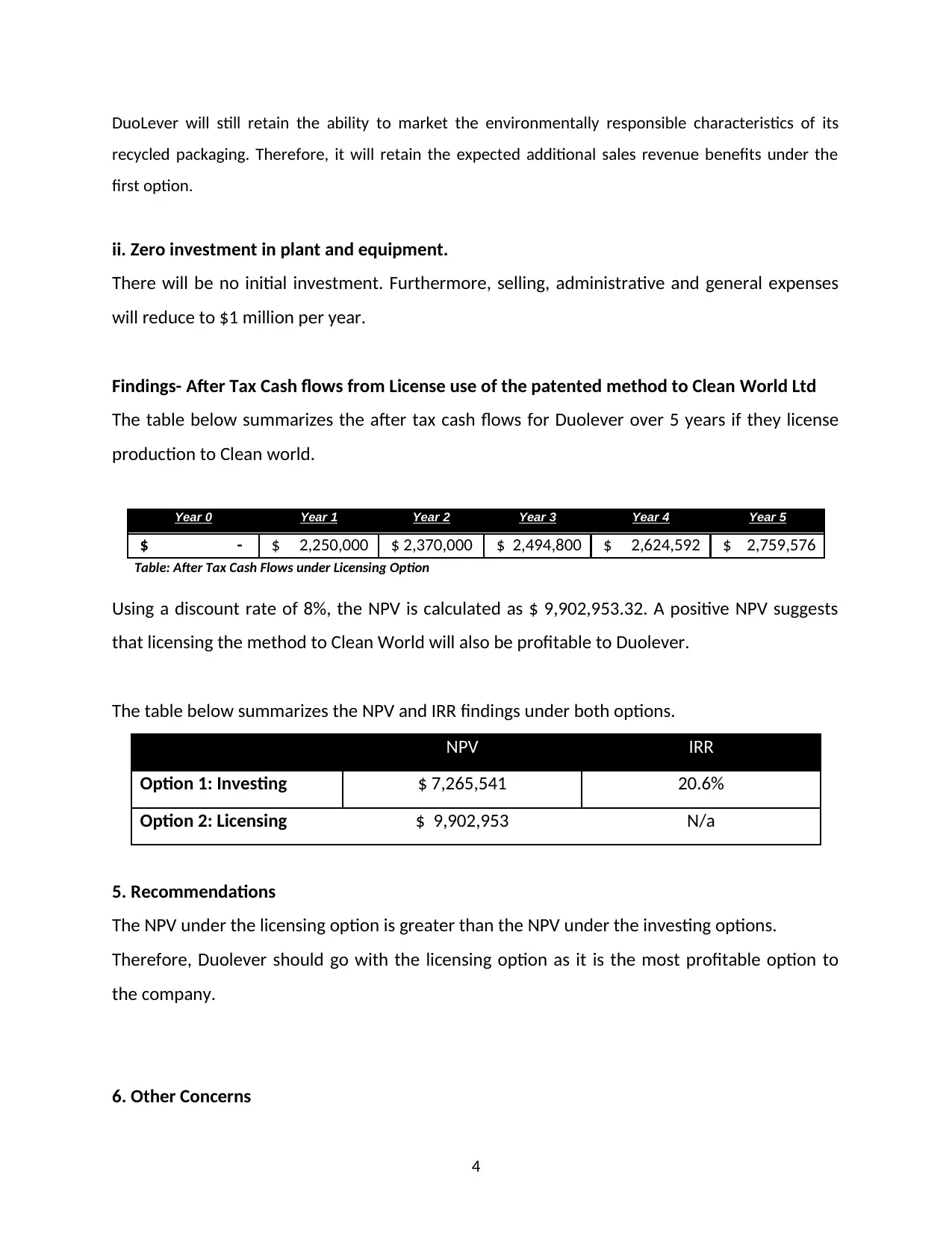
DuoLever will still retain the ability to market the environmentally responsible characteristics of its
recycled packaging. Therefore, it will retain the expected additional sales revenue benefits under the
first option.
ii. Zero investment in plant and equipment.
There will be no initial investment. Furthermore, selling, administrative and general expenses
will reduce to $1 million per year.
Findings- After Tax Cash flows from License use of the patented method to Clean World Ltd
The table below summarizes the after tax cash flows for Duolever over 5 years if they license
production to Clean world.
Year 0 Year 1 Year 2 Year 3 Year 4 Year 5
$ - $ 2,250,000 $ 2,370,000 $ 2,494,800 $ 2,624,592 $ 2,759,576
Table: After Tax Cash Flows under Licensing Option
Using a discount rate of 8%, the NPV is calculated as $ 9,902,953.32. A positive NPV suggests
that licensing the method to Clean World will also be profitable to Duolever.
The table below summarizes the NPV and IRR findings under both options.
NPV IRR
Option 1: Investing $ 7,265,541 20.6%
Option 2: Licensing $ 9,902,953 N/a
5. Recommendations
The NPV under the licensing option is greater than the NPV under the investing options.
Therefore, Duolever should go with the licensing option as it is the most profitable option to
the company.
6. Other Concerns
4
recycled packaging. Therefore, it will retain the expected additional sales revenue benefits under the
first option.
ii. Zero investment in plant and equipment.
There will be no initial investment. Furthermore, selling, administrative and general expenses
will reduce to $1 million per year.
Findings- After Tax Cash flows from License use of the patented method to Clean World Ltd
The table below summarizes the after tax cash flows for Duolever over 5 years if they license
production to Clean world.
Year 0 Year 1 Year 2 Year 3 Year 4 Year 5
$ - $ 2,250,000 $ 2,370,000 $ 2,494,800 $ 2,624,592 $ 2,759,576
Table: After Tax Cash Flows under Licensing Option
Using a discount rate of 8%, the NPV is calculated as $ 9,902,953.32. A positive NPV suggests
that licensing the method to Clean World will also be profitable to Duolever.
The table below summarizes the NPV and IRR findings under both options.
NPV IRR
Option 1: Investing $ 7,265,541 20.6%
Option 2: Licensing $ 9,902,953 N/a
5. Recommendations
The NPV under the licensing option is greater than the NPV under the investing options.
Therefore, Duolever should go with the licensing option as it is the most profitable option to
the company.
6. Other Concerns
4
Paraphrase This Document
Need a fresh take? Get an instant paraphrase of this document with our AI Paraphraser
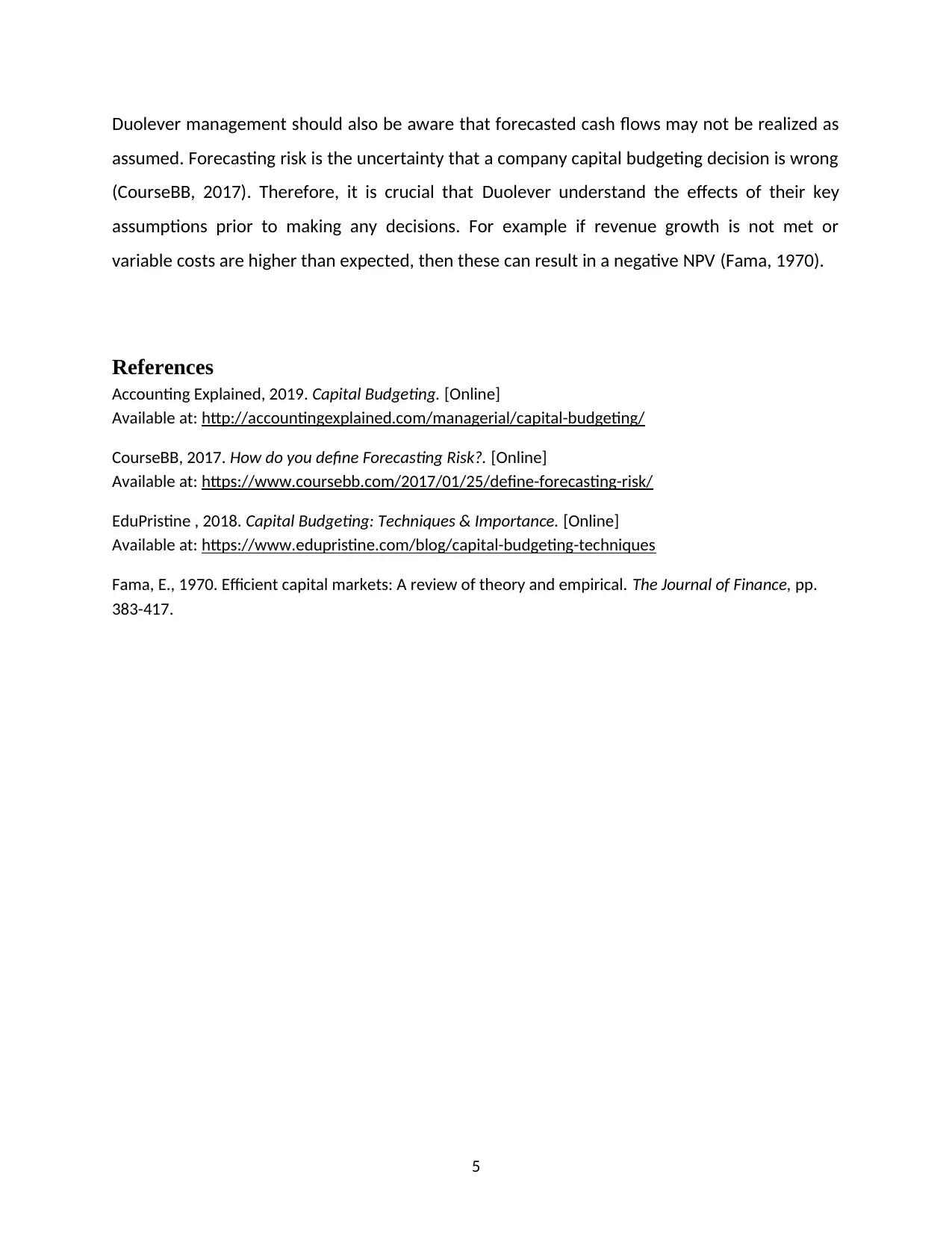
Duolever management should also be aware that forecasted cash flows may not be realized as
assumed. Forecasting risk is the uncertainty that a company capital budgeting decision is wrong
(CourseBB, 2017). Therefore, it is crucial that Duolever understand the effects of their key
assumptions prior to making any decisions. For example if revenue growth is not met or
variable costs are higher than expected, then these can result in a negative NPV (Fama, 1970).
References
Accounting Explained, 2019. Capital Budgeting. [Online]
Available at: http://accountingexplained.com/managerial/capital-budgeting/
CourseBB, 2017. How do you define Forecasting Risk?. [Online]
Available at: https://www.coursebb.com/2017/01/25/define-forecasting-risk/
EduPristine , 2018. Capital Budgeting: Techniques & Importance. [Online]
Available at: https://www.edupristine.com/blog/capital-budgeting-techniques
Fama, E., 1970. Efficient capital markets: A review of theory and empirical. The Journal of Finance, pp.
383-417.
5
assumed. Forecasting risk is the uncertainty that a company capital budgeting decision is wrong
(CourseBB, 2017). Therefore, it is crucial that Duolever understand the effects of their key
assumptions prior to making any decisions. For example if revenue growth is not met or
variable costs are higher than expected, then these can result in a negative NPV (Fama, 1970).
References
Accounting Explained, 2019. Capital Budgeting. [Online]
Available at: http://accountingexplained.com/managerial/capital-budgeting/
CourseBB, 2017. How do you define Forecasting Risk?. [Online]
Available at: https://www.coursebb.com/2017/01/25/define-forecasting-risk/
EduPristine , 2018. Capital Budgeting: Techniques & Importance. [Online]
Available at: https://www.edupristine.com/blog/capital-budgeting-techniques
Fama, E., 1970. Efficient capital markets: A review of theory and empirical. The Journal of Finance, pp.
383-417.
5
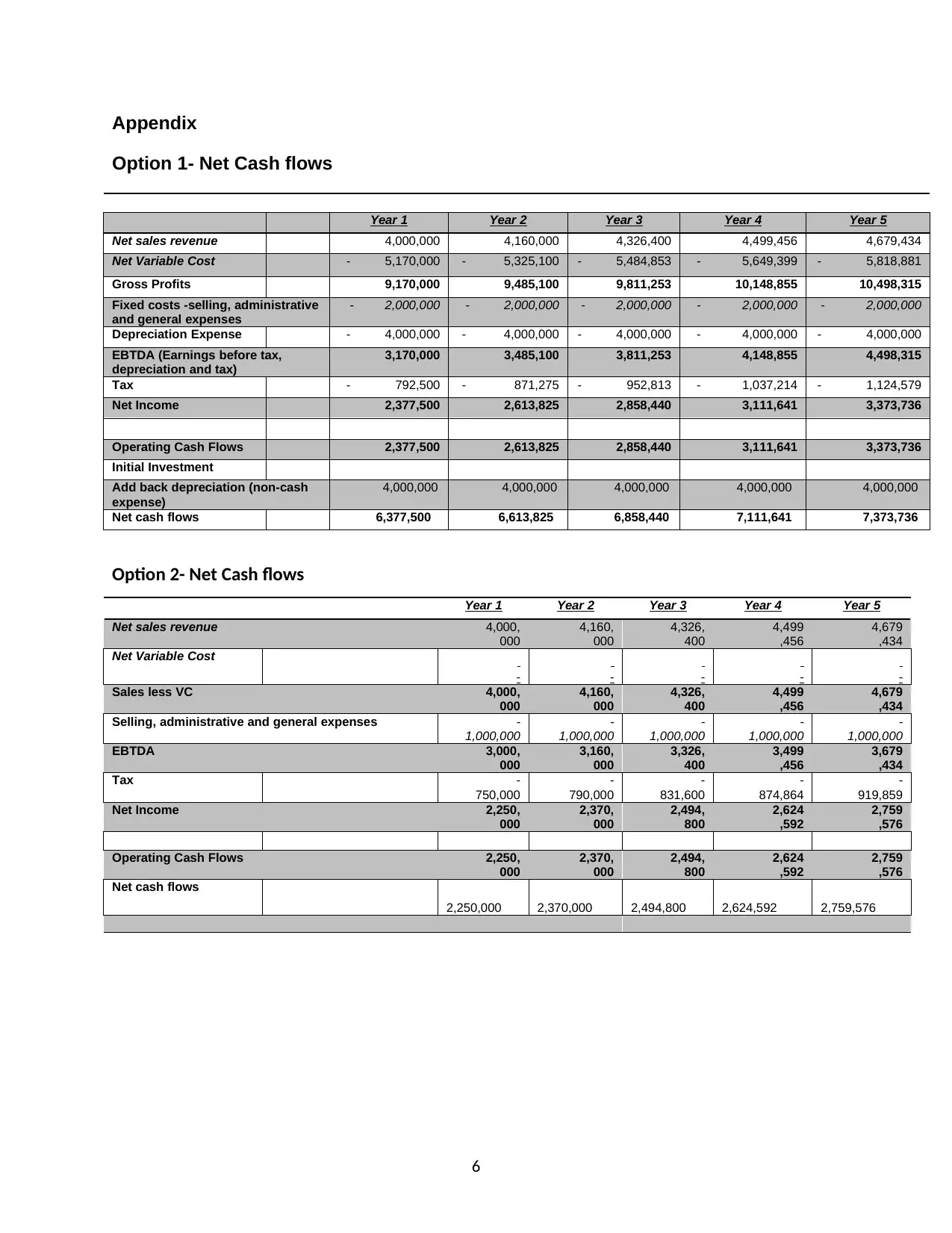
Appendix
Option 1- Net Cash flows
Year 1 Year 2 Year 3 Year 4 Year 5
Net sales revenue 4,000,000 4,160,000 4,326,400 4,499,456 4,679,434
Net Variable Cost - 5,170,000 - 5,325,100 - 5,484,853 - 5,649,399 - 5,818,881
Gross Profits 9,170,000 9,485,100 9,811,253 10,148,855 10,498,315
Fixed costs -selling, administrative
and general expenses
- 2,000,000 - 2,000,000 - 2,000,000 - 2,000,000 - 2,000,000
Depreciation Expense - 4,000,000 - 4,000,000 - 4,000,000 - 4,000,000 - 4,000,000
EBTDA (Earnings before tax,
depreciation and tax)
3,170,000 3,485,100 3,811,253 4,148,855 4,498,315
Tax - 792,500 - 871,275 - 952,813 - 1,037,214 - 1,124,579
Net Income 2,377,500 2,613,825 2,858,440 3,111,641 3,373,736
Operating Cash Flows 2,377,500 2,613,825 2,858,440 3,111,641 3,373,736
Initial Investment
Add back depreciation (non-cash
expense)
4,000,000 4,000,000 4,000,000 4,000,000 4,000,000
Net cash flows 6,377,500 6,613,825 6,858,440 7,111,641 7,373,736
Option 2- Net Cash flows
Year 1 Year 2 Year 3 Year 4 Year 5
Net sales revenue 4,000,
000
4,160,
000
4,326,
400
4,499
,456
4,679
,434
Net Variable Cost
- - - - -
Sales less VC 4,000,
000
4,160,
000
4,326,
400
4,499
,456
4,679
,434
Selling, administrative and general expenses -
1,000,000
-
1,000,000
-
1,000,000
-
1,000,000
-
1,000,000
EBTDA 3,000,
000
3,160,
000
3,326,
400
3,499
,456
3,679
,434
Tax -
750,000
-
790,000
-
831,600
-
874,864
-
919,859
Net Income 2,250,
000
2,370,
000
2,494,
800
2,624
,592
2,759
,576
Operating Cash Flows 2,250,
000
2,370,
000
2,494,
800
2,624
,592
2,759
,576
Net cash flows
2,250,000 2,370,000 2,494,800 2,624,592 2,759,576
6
Option 1- Net Cash flows
Year 1 Year 2 Year 3 Year 4 Year 5
Net sales revenue 4,000,000 4,160,000 4,326,400 4,499,456 4,679,434
Net Variable Cost - 5,170,000 - 5,325,100 - 5,484,853 - 5,649,399 - 5,818,881
Gross Profits 9,170,000 9,485,100 9,811,253 10,148,855 10,498,315
Fixed costs -selling, administrative
and general expenses
- 2,000,000 - 2,000,000 - 2,000,000 - 2,000,000 - 2,000,000
Depreciation Expense - 4,000,000 - 4,000,000 - 4,000,000 - 4,000,000 - 4,000,000
EBTDA (Earnings before tax,
depreciation and tax)
3,170,000 3,485,100 3,811,253 4,148,855 4,498,315
Tax - 792,500 - 871,275 - 952,813 - 1,037,214 - 1,124,579
Net Income 2,377,500 2,613,825 2,858,440 3,111,641 3,373,736
Operating Cash Flows 2,377,500 2,613,825 2,858,440 3,111,641 3,373,736
Initial Investment
Add back depreciation (non-cash
expense)
4,000,000 4,000,000 4,000,000 4,000,000 4,000,000
Net cash flows 6,377,500 6,613,825 6,858,440 7,111,641 7,373,736
Option 2- Net Cash flows
Year 1 Year 2 Year 3 Year 4 Year 5
Net sales revenue 4,000,
000
4,160,
000
4,326,
400
4,499
,456
4,679
,434
Net Variable Cost
- - - - -
Sales less VC 4,000,
000
4,160,
000
4,326,
400
4,499
,456
4,679
,434
Selling, administrative and general expenses -
1,000,000
-
1,000,000
-
1,000,000
-
1,000,000
-
1,000,000
EBTDA 3,000,
000
3,160,
000
3,326,
400
3,499
,456
3,679
,434
Tax -
750,000
-
790,000
-
831,600
-
874,864
-
919,859
Net Income 2,250,
000
2,370,
000
2,494,
800
2,624
,592
2,759
,576
Operating Cash Flows 2,250,
000
2,370,
000
2,494,
800
2,624
,592
2,759
,576
Net cash flows
2,250,000 2,370,000 2,494,800 2,624,592 2,759,576
6
⊘ This is a preview!⊘
Do you want full access?
Subscribe today to unlock all pages.

Trusted by 1+ million students worldwide
1 out of 6
Related Documents
Your All-in-One AI-Powered Toolkit for Academic Success.
+13062052269
info@desklib.com
Available 24*7 on WhatsApp / Email
![[object Object]](/_next/static/media/star-bottom.7253800d.svg)
Unlock your academic potential
Copyright © 2020–2025 A2Z Services. All Rights Reserved. Developed and managed by ZUCOL.





